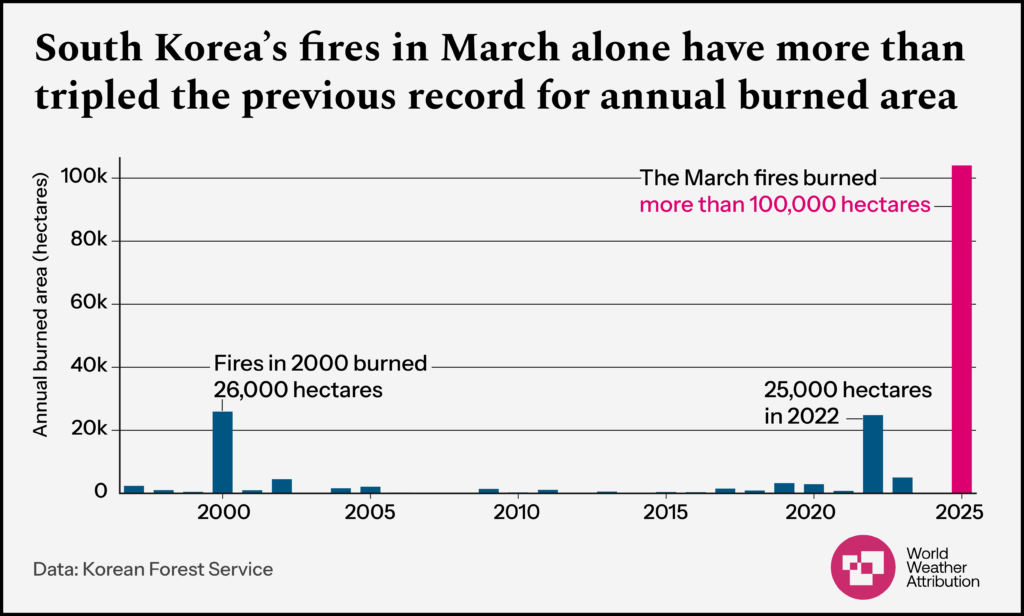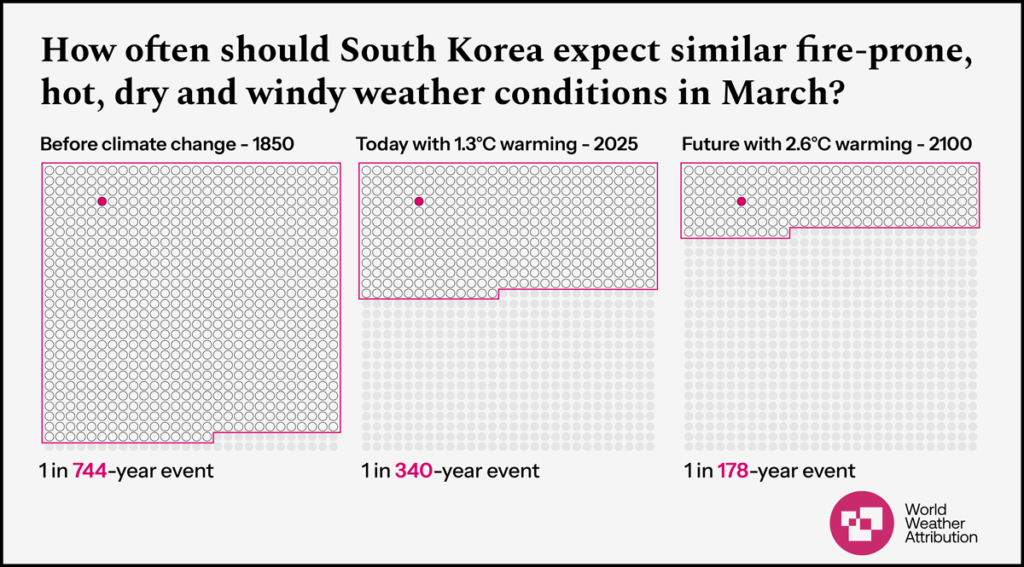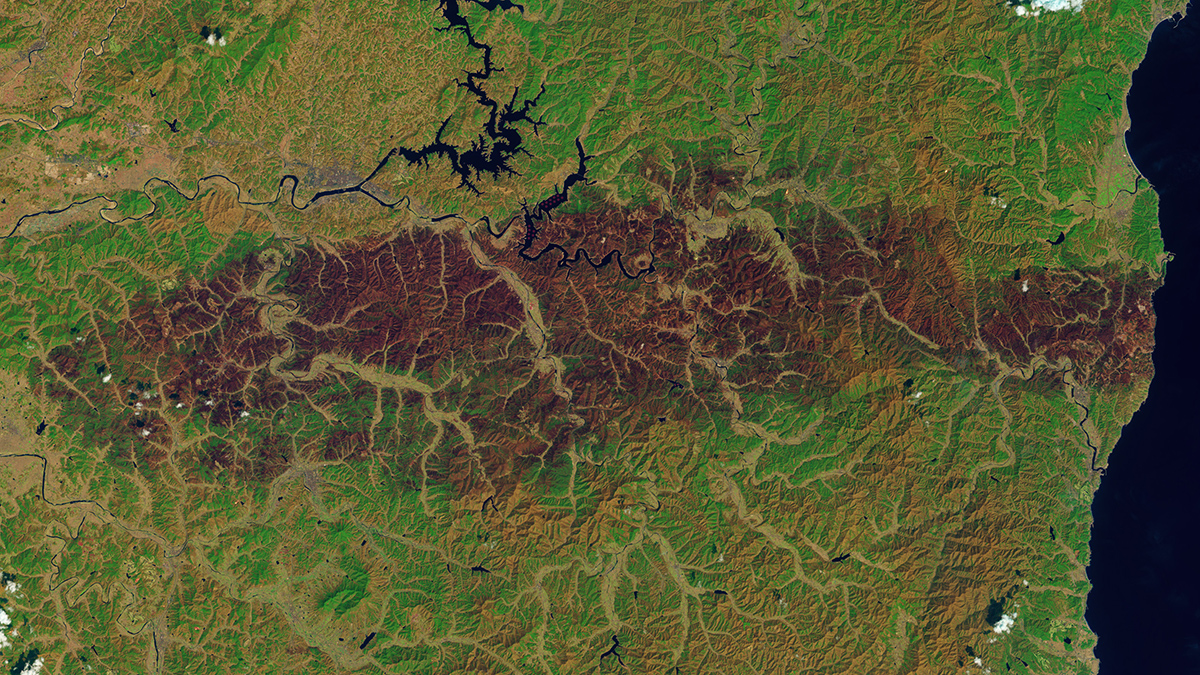Historic wildfires broke out in South Korea in late March 2025, killing 32 people, injuring 45, and displacing about 37,000. In total, the fires burned more than 100,000 hectares (about 247,000 acres), nearly quadruple the area that burned in the country’s previous worst recorded fire season in 2000. (In comparison, the January 2025 Palisades and Eaton Fires in Southern California burned about 91,000 hectares, or 37,000 acres.)
“This study adds to a growing body of science showing how climate change is making weather conditions more favorable to dangerous wildfires.”
A new study by scientists with World Weather Attribution (WWA) suggests that atmospheric warming—caused primarily by fossil fuel burning—made the hot, dry, and windy conditions that drove the South Korean fires about twice as likely and 15% more intense.
About 5,000 buildings burned, including homes, industrial structures, farms, and cultural heritage sites such as the Gounsa Temple in Uiseong, which was originally built in 618 CE.

“The scale and speed of the fires were unlike anything we’ve ever experienced in South Korea,” said June-Yi Lee, an atmospheric scientist at Pusan National University and the Institute for Basic Science, in a statement. “This study adds to a growing body of science showing how climate change is making weather conditions more favorable to dangerous wildfires.”
Hot, Dry, and Windy
WWA researchers examined the Hot-Dry-Windy Index (HDWI) across the entire country for the month of March. This metric calculates fire risk from temperature, humidity, and wind speed observations.
The combination of high temperatures, low humidity, and high wind speeds that occurred from 22 to 26 March were unusual, even for today’s climate, the researchers found. Such conditions are expected to occur in March only once every 340 years. But this combination of conditions would have been even rarer in a preindustrial climate, occurring only once every 744 years.
The study suggests that the trend in the HDWI was driven primarily by unseasonably high temperatures.
“From March 22–26, the daily maximum average temperature in southeastern Korea averaged around 25°C, which was 10°C higher than the normal March average,” Lee said in a press briefing. Little rain fell in the region this winter, which, combined with high temperatures, led to drier, more flammable fuels. Relative humidity was around 20% at the time of the fires, not unusual for March. Wind speeds on 25 March reached up to 25 meters per second, a short-lived spike that helped the fires spread quickly.
The WWA team also calculated that if the climate warms by another 1.3°C by 2100, the HDWI will continue to increase, with the conditions behind such fires growing another 2 times as likely.
The nature of WWA’s rapid response studies means they are not peer reviewed, but they have published peer-reviewed studies on the methodology they use in all of their analyses. The study marks the World Weather Attribution’s 100th rapid analysis since the organization formed in 2014. It is the sixth to focus on a wildfire.

A Strong Case
ClimaMeter, another project that examines how extreme weather events may have been affected by a changing climate, released a study about South Korea’s wildfires on 25 March. (As with the WWA study, it was not peer reviewed but used peer-reviewed methods.)
ClimaMeter uses a different methodology than WWA does but had similar findings, reporting that the meteorological conditions leading up to the fires were about 2°C hotter, 30% drier, and 10% windier compared with similar past events.
“For the moment, it’s more difficult to prove that climate change did not affect an event.”
Davide Faranda, a physicist with the French National Centre for Scientific Research and coordinator of ClimaMeter, pointed out that their study showed climate change strengthened the meteorological conditions conducive to fires, not necessarily that climate change caused the fires. He was not involved with the WWA study but noted that the two groups’ rapid response studies often arrive at similar or complementary findings.
“For the moment, it’s more difficult to prove that climate change did not affect an event,” he said.
“A decade ago, the influence of climate change on events was less clear. But now it’s undeniable. The wildfires in South Korea are a case in point,” said Friederike Otto, WWA colead and a climatologist at Imperial College London, in a statement.
—Emily Dieckman (@emfurd.bsky.social), Associate Editor

